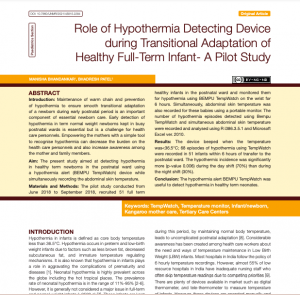
Introduction
Maintenance of warm chain and prevention of hypothermia to ensure smooth transitional adaptation of a newborn during early postnatal period is an important component of essential newborn care. Early detection of hypothermia in term normal weight newborns kept in busy postnatal wards is essential but is a challenge for health
care personnels. Empowering the mothers with a simple tool to recognise hypothermia can decrease the burden on the health care personnels and also increase awareness among the mother and family members.
Aim
The present study aimed at detecting hypothermia in healthy term newborns in the postnatal ward using a hypothermia alert (BEMPU TempWatch) device while simultaneously recording the abdominal skin temperature.
Materials and Methods
The pilot study conducted from June 2018 to September 2018, recruited 51 full term healthy infants in the postnatal ward and monitored them for hypothermia using BEMPU TempWatch on the wrist for 6 hours. Simultaneously, abdominal skin temperature was also recorded for these babies using a portable monitor. The number of hypothermia episodes detected using Bempu TempWatch and simultaneous abdominal skin temperature were recorded and analysed using R i386.3.5.1 and Microsoft Excel ver. 2010.
Results
The device beeped when the temperature was<36.5°C; 68 episodes of hypothermia using TempWatch were recorded in 51 infants within 6 hours of transfer to the postnatal ward. The hypothermic incidence was significantly more (p-value 0.006) during the day shift (70%) than during the night shift (30%).